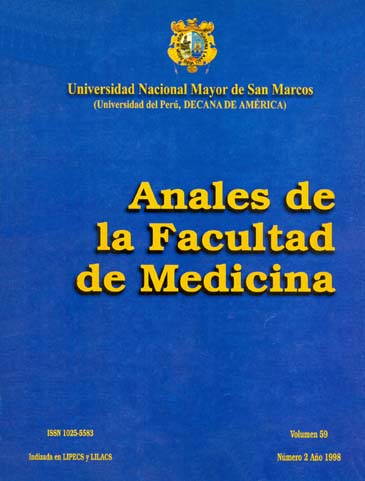Auto Oxidation Kinetics of Ascorbate by Cupric Ions
DOI:
https://doi.org/10.15381/anales.v59i2.4632Keywords:
Ascorbic Acid, Copper, Free Radicals, Redox, AntioxidantsAbstract
Ascorbate autoxidation catalyzed Cu2 + is performed via a first order reaction , a process that is dependent upon the concentration of Cu2 + and that follows a saturation emetic . This suggests that in the sequence an intermediate complex catalyst which would limit the formation of reaction products , one of which is a free hydroxyl radical is formed. Thiourea markedly inhibits autoxidation reaction , while it has no effect glycerol . Ascorbate and Cu2 + , used at concentrations that autoxidation occurs, do not cleave the disulfide bond of DTNB . Histidine and citrate inhibit both autoxidation reaction as breaking of the disulfide bond of DTNB . These results suggest that the rupture of the disulfide bridge of DTNB be realized with the intervention of the hydroxyl free radicals generated by the ascorbate system / Cu + , and in parallel by a process of reduction or hydrolysis .Downloads
Published
1998-06-15
Issue
Section
Trabajos originales
License
Copyright (c) 1998 Luzmila Troncoso, Emilio Guija

This work is licensed under a Creative Commons Attribution-NonCommercial-ShareAlike 4.0 International License.
Those authors who have publications with this magazine accept the following terms:
- Authors will retain their copyrights and guarantee the journal the right of first publication of their work, which will be simultaneously subject to Creative Commons Attribution License that allows third parties to share the work as long as its author and its first publication this magazine are indicated.
- Authors may adopt other non-exclusive licensing agreements for the distribution of the version of the published work (eg, deposit it in an institutional electronic file or publish it in a monographic volume) provided that the initial publication in this magazine is indicated.
- Authors are allowed and recommended to disseminate their work over the Internet (eg: in institutional telematic archives or on their website) before and during the submission process, which It can produce interesting exchanges and increase quotes from the published work. (See El efecto del acceso abierto ).
How to Cite
1.
Troncoso L, Guija E. Auto Oxidation Kinetics of Ascorbate by Cupric Ions. An Fac med [Internet]. 1998 Jun. 15 [cited 2024 Jul. 8];59(2):105-10. Available from: https://revistasinvestigacion.unmsm.edu.pe/index.php/anales/article/view/4632















